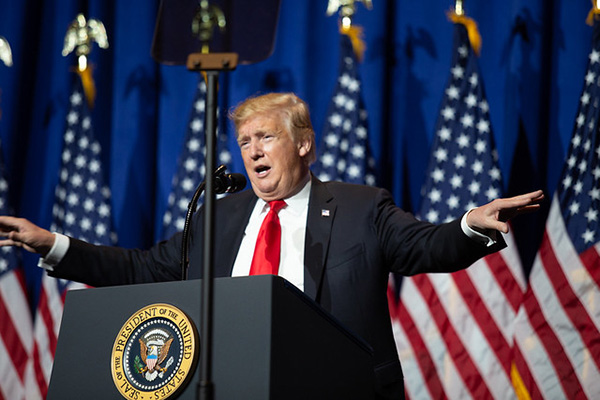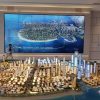Introduction
This paper is an analysis of the discursive practices of the international economic policy of the Administration of President Donald Trump, writ large. Within this conceptual context it offers an empirical case study of the US-China relationship across the spectrum, from tariff conflict through to the growing struggle for control of the 21st century high-technology industries. The argument is that the Trump Administration utilises the discursive practices of what some scholars call ‘securitisation’ (Buzan et al., 1998) through to what might more appropriately be described as a discourse of ‘economic warfare’.
The paper is in four parts. Part 1 provides a brief discussion of the changing historical and international context of the study. Part 2 provides a conceptual discussion of the discursive practices of securitisation, economic statecraft and economic warfare on the one hand and the theory of international trade captured in the idea of the rise and fall of mercantilism and its re-emergence in the international economic agenda of the Trump Administration on the other. Part 3 looks at these concepts as they pertain to current US international economic policy. Part 4 concentrates on US policy towards China particularly. The paper concludes with some reflections on the success or otherwise of contemporary US policy.
The global context
The cooperation that developed during the period of US ‘self-binding’ hegemonic control (Martin, 2004) over a liberal international order had been under strain in the US since the 1980s when the bilateral deficits with Japan became a major political issue. But it has been since the financial crisis of 2008 that the order has really begun to unravel. The Japan challenge was not sustained but great power competition from both China and Russia has grown. Always fragile, the popular consensus in support of a global liberal order –which was only ever partially liberal and partially global (see Acharya, 2017)– has further dissipated as strong ideological populist challenges have fuelled nationalist politics with attendant practical implications for economic globalisation and international relations in the post 2008 era (see Higgott & Proud, 2017).
This unravelling and great power competition pre-dates Donald Trump becoming President of the US. But it has been exacerbated by his economic nationalist counter-agenda to globalism; an agenda voiced not only by President Trump but also by subordinates in his close policy community –initially by Steve Bannon, but also others such as US Trade Representative Robert Lighthizer, Commerce Secretary Wilbur Ross, Treasury Secretary Steven Mnuchin and Special Economic Adviser Peter Navarro–.2
As this paper will argue, the challenges faced in a search for a new, post-liberal global equilibrium are reflected in both the conceptualisation and practice of economic securitisation and warfare as an instrument of US policy. The contours of any new order will be a highly contested with an increasing interdependence of the two key issues areas –economics and security– and increasing competition between the two principal combatants –the US and China. What might have started as a fairly traditional recourse to a protectionist trade agenda is steadily, and rapidly, morphing into a wider battle between the US and China across the whole spectrum of relations, and especially the battle for technological ascendency in the 21st century. We are witnessing not simply a rhetorical securitisation of US economic policy discourse but a more intense economic and political response to economic globalism in general, and the ascendency of China as a rival global economic power in particular.
For much of the post-World War II era, the relevant government agencies in the US (especially the US Treasury, abetted by the USTR) and the many interested trade and commerce lobbies and pressure groups had sought to treat international economic policy in general, and trade policy in particular, in a manner different to the normal rules of foreign and security policy. Trade policy was seen as a quasi-preserved domain with its own epistemic discourse. This has changed in the current era, where expert knowledge, when not directly rejected or increasingly belittled, is less valued (see Nicholls, 2017).
We are now in an era in which international trade policy, underpinned by a belief in the welfare-enhancing nature of trade openness is under challenge (see Irwin, 2017). This should not lead us into thinking that the globalisation of the international economy as a set of sinews, networks, activities and practices that developed over the last 40 years are somehow coming undone. This is clearly not the case (see Slaughter, 2018; and Baldwin, 2018). Rather, US policy has undergone a major change. An open liberal economic system has been characterised as a licence for others to cheat in their economic relationship with the US.
Concepts and theories
Discursive practices: from securitisation to economic warfare
Following 9/11 it became fashionable in some academic and policy quarters to talk about the ‘securitisation’ of US international economic policy. In academic language, securitisation (following the work of the Copenhagen School) was defined as a set of socially constructed and contextual speech acts and processes in which ‘… an issue is framed as a security problem’ (Waever, 1995, p. 75; and Buzan et al., 1998). Evidence of the securitisation of economic globalisation in US policy can be traced far back: from the time of the Raegan Administration and its introduction of the use of VRAs and VERs against the Japanese in iron and steel, machine tools and cars in the 1980s (Reich, 1989) through the to the Bush Administration. It was 9/11 that (perhaps unsurprisingly) firmed up the trend as the Administration proved unable to resist the siren calls to link the narratives of foreign economic and security policy.
For the Bush Administration, globalisation became not only an economic issue but also a ‘security’ problem. As a consequence, the discourse and practice of the securitisation of foreign economic policy developed accordingly. This trend was particularly acute in trade policy where, to illustrate, the granting of the bilateral Free Trade Agreements (FTAs) under negotiation at the time to those who supported the US Gulf War Two initiative (Australia and Singapore) contrasted with the explicit withholding of them from those who refused to join the Gulf War coalition (New Zealand and Chile) (see Higgott, 2004).
The earlier discourse of securitisation did not operationalise the concept of economic statecraft, let alone economic ‘warfare’ –concepts largely applied to non-liberal regimes, notably Russia and China. This study will demonstrate a step change between the Bush era and the contemporary era of the Trump Administration. It will demonstrate that contextual global change and the empirical narrative of international economic policy in general, and trade policy in particular, under the current Trump Administration requires a recognition of both the similarities and differences in the securitisation-economic warfare dialogue not required in the age of George W. Bush. Current US policy is taking us beyond both the securitisation problematic of the Copenhagen School and the traditional understanding of economic statecraft restated recently by Blackwill & Harris (2016). Rather, current US international economic policy should be interpreted through the discursive lenses of an aggressive and pro-active –as opposed to the earlier defensive and reactive– economic warfare.
Current US strategy in trade policy under the Trump Administration offers a counter-veiling argument to the notion that democracies will invariably prefer, à la Joseph Nye, (2004) a soft power diplomatic approach to more atavistic approaches. The preference is now to challenge longstanding commitments to multilateral collective action in the global trade regime with a preference for a strategy based as much on threat as on reward. A comparative analysis of the Bush and Trump Administrations suggests two major differences:
- The securitisation strategy of the Bush Administration after 9/11 was underwritten by assumptions of ‘existential threat’ but still with a significant commitment to multilateral institutionalism. By contrast in the Trump Administration’s strategy, without formally articulating it, it is clear that President Trump has a longstanding belief in a mercantilist view of trade with little or no commitment to multilateral institutionalism.
- The impact of the communication and technological revolutions on how the dissemination of a securitised trade policy under the current US Administration is practiced, when compared to the tools at the disposal of the Bush Administration, is both more intense and more sophisticated. George Bush did not have the populist communicative skills of Donald Trump nor the weaponry of digital social media, especially Twitter. The message of economic warfare is much easier to disseminate today.
Current strategy and policy harness the discursive instruments, tools and practices short of war to secure the enhancement of national objectives over those of adversaries. If we use the language of security studies we are seeing what Mahnken et al. call ‘… the coercive use of non military instruments to alter adversary behaviour’ (2018, p. 3). This allows us to demonstrate the degree to which our understanding of the discursive practices of trade war can be extended in two ways:
- To include allies as well as adversaries as targets.
- To extend our focus beyond Russia and China, to the discursive practices of econo-political warfare beyond the traditional understandings of US economic statecraft in recent years (see Blackwill & Harris, 2016).
This comparison of language and practice in US international economic policy is not of courses to suggest any wider similarity between the US on the one hand and China and Russia on the other. The US, for all its current problems, remains a robust democracy while Russia and China are both strongly authoritarian states. But comparative discursive narratives can be identified. In their case study on Russia, Mahnken et al. (2018, p. 10) identify what they see as key themes in the post revolution Bolshevik narrative. Four of the six they identify –(a) ‘we are special’; (b) the ‘country is threatened’; (c) there is a ‘sacred mission’; and (d) ‘victory is assured’– do warrant comparison and find resonance in the Trumpian international economic playbook that stresses:
- The residual myth of American ‘exceptionalism’ (‘we are special’).
- That the US is disadvantaged by the cheating and free riding behaviour of its major trading partners (‘the country is threatened’).
- The presidential mission is to ‘Make America Great Again’ (MAGA as ‘a sacred mission’).
- In the economic domain, this has meant a turn to aggressive and unilateral protectionist measures addressed to competitors and allies alike and based on the premise that, in Trump’s own words, ‘trade wars are easy’ (‘victory is assured’).
The analogy permits two further discursive comparisons. First, Vladimir Putin believes Russia was betrayed by the West after the Cold War with its support for the ‘colour’ revolutions in regional neighbours and the eastward expansion of NATO. Similarly, this sense of betrayal is mirrored in the US President’s belief that European allies have been free-riders on US largesse in both the security domain (NATO) and the economic domain (trade imbalances). If his resentments reflect core elements of Trump’s world view, then they lend themselves to explaining his policy responses: bilateralism, transactionalism, aggressive competition, and punishment and retaliation rather than cooperation and multilateralism. In addition, the observation of Trump’s attitudes towards the US’s European allies (for example, his position on Brexit and suggestions to President Macron that France leave the EU) also suggests a willingness to sow division amongst allies where possible. Secondly, the MAGA discourse mirrors Xi Jingping’s emphasis on enhancing respect for China globally after years of humiliation. This theme –that the US must be respected– is to be found in much presidential rhetoric about the lack of deference paid to the US by ungrateful allies.
Richard Higgott, PhD, FRSA, FAcSS
Emeritus Professor of International Political Economy, University of Warwick
Research Professor, Institute of European Studies and Distinguished Professor of Diplomacy, Vesalius College of Global Affairs, Vrije Universiteit Brussel
1 The author is grateful to Luis Simon, Patrick Low, Simon Reich, Jaihong Chen, John Hart, Anthony Milner and Uli Penzkofer for their helpful comments.
2 See Navarros’s documentary, Death by China



